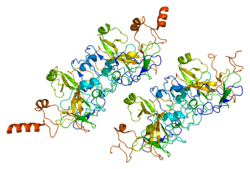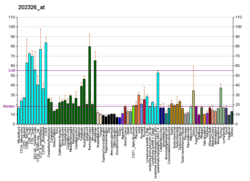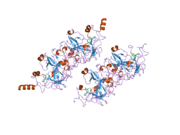EHMT2
Euchromatic histone-lysine N-methyltransferase 2 (EHMT2), also known as G9a, is an enzyme, specifically a histone methyltransferase, that in humans is encoded by the EHMT2 gene.[5][6][7] G9a catalyzes the mono- and di-methylated states of histone H3 at lysine residue 9 (i.e., H3K9me1 and H3K9me2) and lysine residue 27 (H3K27me1 and HeK27me2).[8]
Function
A cluster of genes, BAT1-BAT5, has been localized in the vicinity of the genes for TNF alpha and TNF beta. This gene is found near this cluster; it was mapped near the gene for C2 within a 120-kb region that included a HSP70 gene pair. These genes are all within the human major histocompatibility complex class III region. This gene was thought to be two different genes, NG36 and G9a, adjacent to each other but a recent publication shows that there is only a single gene. The protein encoded by this gene is thought to be involved in intracellular protein-protein interaction. There are three alternatively spliced transcript variants of this gene but only two are fully described.[7]
G9a and G9a-like protein, another histone-lysine N-methyltransferase, catalyze the synthesis of H3K9me2, which is a repressive mark.[8][9][10] G9a is an important control mechanism for epigenetic regulation within the nucleus accumbens (NAcc);[11] reduced G9a expression in the NAcc plays a central role in mediating the development of an addiction.[11] G9a opposes increases in ΔFosB expression via H3K9me2 and is suppressed by ΔFosB.[11][12] G9a exerts opposite effects to that of ΔFosB on drug-related behavior (e.g., self-administration) and synaptic remodeling (e.g., dendritic arborization – the development of additional tree-like dendritic branches and spines) in the nucleus accumbens, and therefore opposes ΔFosB's function as well as increases in its expression.[11] G9a and ΔFosB share many of the same gene targets.[13]
Interactions
EHMT2 has been shown to interact with KIAA0515 and the prostate tissue associated homeodomain protein NKX3.1.[14][15]
References
- 1 2 3 ENSG00000224143, ENSG00000206376, ENSG00000204371, ENSG00000227333, ENSG00000232045, ENSG00000236759 GRCh38: Ensembl release 89: ENSG00000238134, ENSG00000224143, ENSG00000206376, ENSG00000204371, ENSG00000227333, ENSG00000232045, ENSG00000236759 - Ensembl, May 2017
- 1 2 3 GRCm38: Ensembl release 89: ENSMUSG00000013787 - Ensembl, May 2017
- ↑ "Human PubMed Reference:".
- ↑ "Mouse PubMed Reference:".
- ↑ Milner CM, Campbell RD (March 1993). "The G9a gene in the human major histocompatibility complex encodes a novel protein containing ankyrin-like repeats". The Biochemical Journal. 290 (Pt 3): 811–8. doi:10.1042/bj2900811. PMC 1132354. PMID 8457211.
- ↑ Tachibana M, Sugimoto K, Fukushima T, Shinkai Y (July 2001). "Set domain-containing protein, G9a, is a novel lysine-preferring mammalian histone methyltransferase with hyperactivity and specific selectivity to lysines 9 and 27 of histone H3". The Journal of Biological Chemistry. 276 (27): 25309–17. doi:10.1074/jbc.M101914200. PMID 11316813.
- 1 2 "Entrez Gene: EHMT2 euchromatic histone-lysine N-methyltransferase 2".
- 1 2 Nestler EJ (August 2015). "Role of the Brain's Reward Circuitry in Depression: Transcriptional Mechanisms". International Review of Neurobiology. 124: 151–70. doi:10.1016/bs.irn.2015.07.003. PMC 4690450. PMID 26472529.
- ↑ "Histone-lysine N-methyltransferase, H3 lysine-9 specific 3". HIstome: The Histone Infobase. Retrieved 8 June 2018.
- ↑ "Histone-lysine N-methyltransferase, H3 lysine-9 specific 5". HIstome: The Histone Infobase. Retrieved 8 June 2018.
- 1 2 3 4 Nestler EJ (January 2014). "Epigenetic mechanisms of drug addiction". Neuropharmacology. 76 Pt B: 259–68. doi:10.1016/j.neuropharm.2013.04.004. PMC 3766384. PMID 23643695.
- ↑ Whalley K (December 2014). "Psychiatric disorders: a feat of epigenetic engineering". Nature Reviews. Neuroscience. 15 (12): 768–9. doi:10.1038/nrn3869. PMID 25409693.
- ↑ Robison AJ, Nestler EJ (October 2011). "Transcriptional and epigenetic mechanisms of addiction". Nature Reviews. Neuroscience. 12 (11): 623–37. doi:10.1038/nrn3111. PMC 3272277. PMID 21989194.
Figure 4: Epigenetic basis of drug regulation of gene expression - ↑ Rual JF, Venkatesan K, Hao T, Hirozane-Kishikawa T, Dricot A, Li N, Berriz GF, Gibbons FD, Dreze M, Ayivi-Guedehoussou N, Klitgord N, Simon C, Boxem M, Milstein S, Rosenberg J, Goldberg DS, Zhang LV, Wong SL, Franklin G, Li S, Albala JS, Lim J, Fraughton C, Llamosas E, Cevik S, Bex C, Lamesch P, Sikorski RS, Vandenhaute J, Zoghbi HY, Smolyar A, Bosak S, Sequerra R, Doucette-Stamm L, Cusick ME, Hill DE, Roth FP, Vidal M (October 2005). "Towards a proteome-scale map of the human protein-protein interaction network". Nature. 437 (7062): 1173–8. doi:10.1038/nature04209. PMID 16189514.
- ↑ Dutta A, et al. (Jun 2016). "Identification of an NKX3.1-G9a-UTY transcriptional regulatory network that controls prostate differentiation". Science.
Further reading
- Spies T, Bresnahan M, Strominger JL (November 1989). "Human major histocompatibility complex contains a minimum of 19 genes between the complement cluster and HLA-B". Proceedings of the National Academy of Sciences of the United States of America. 86 (22): 8955–8. doi:10.1073/pnas.86.22.8955. PMC 298409. PMID 2813433.
- Brown SE, Campbell RD, Sanderson CM (December 2001). "Novel NG36/G9a gene products encoded within the human and mouse MHC class III regions". Mammalian Genome. 12 (12): 916–24. doi:10.1007/s00335-001-3029-3. PMID 11707778.
- Ogawa H, Ishiguro K, Gaubatz S, Livingston DM, Nakatani Y (May 2002). "A complex with chromatin modifiers that occupies E2F- and Myc-responsive genes in G0 cells". Science. 296 (5570): 1132–6. doi:10.1126/science.1069861. PMID 12004135.
- Tachibana M, Sugimoto K, Nozaki M, Ueda J, Ohta T, Ohki M, Fukuda M, Takeda N, Niida H, Kato H, Shinkai Y (July 2002). "G9a histone methyltransferase plays a dominant role in euchromatic histone H3 lysine 9 methylation and is essential for early embryogenesis". Genes & Development. 16 (14): 1779–91. doi:10.1101/gad.989402. PMC 186403. PMID 12130538.
- Shi Y, Sawada J, Sui G, el Affar B, Whetstine JR, Lan F, Ogawa H, Luke MP, Nakatani Y, Shi Y (April 2003). "Coordinated histone modifications mediated by a CtBP co-repressor complex". Nature. 422 (6933): 735–8. doi:10.1038/nature01550. PMID 12700765.
- Xie T, Rowen L, Aguado B, Ahearn ME, Madan A, Qin S, Campbell RD, Hood L (December 2003). "Analysis of the gene-dense major histocompatibility complex class III region and its comparison to mouse". Genome Research. 13 (12): 2621–36. doi:10.1101/gr.1736803. PMC 403804. PMID 14656967.
- Roopra A, Qazi R, Schoenike B, Daley TJ, Morrison JF (June 2004). "Localized domains of G9a-mediated histone methylation are required for silencing of neuronal genes". Molecular Cell. 14 (6): 727–38. doi:10.1016/j.molcel.2004.05.026. PMID 15200951.
- Nishio H, Walsh MJ (August 2004). "CCAAT displacement protein/cut homolog recruits G9a histone lysine methyltransferase to repress transcription". Proceedings of the National Academy of Sciences of the United States of America. 101 (31): 11257–62. doi:10.1073/pnas.0401343101. PMC 509191. PMID 15269344.
- Collins RE, Tachibana M, Tamaru H, Smith KM, Jia D, Zhang X, Selker EU, Shinkai Y, Cheng X (February 2005). "In vitro and in vivo analyses of a Phe/Tyr switch controlling product specificity of histone lysine methyltransferases". The Journal of Biological Chemistry. 280 (7): 5563–70. doi:10.1074/jbc.M410483200. PMC 2696276. PMID 15590646.
- Rual JF, Venkatesan K, Hao T, Hirozane-Kishikawa T, Dricot A, Li N, Berriz GF, Gibbons FD, Dreze M, Ayivi-Guedehoussou N, Klitgord N, Simon C, Boxem M, Milstein S, Rosenberg J, Goldberg DS, Zhang LV, Wong SL, Franklin G, Li S, Albala JS, Lim J, Fraughton C, Llamosas E, Cevik S, Bex C, Lamesch P, Sikorski RS, Vandenhaute J, Zoghbi HY, Smolyar A, Bosak S, Sequerra R, Doucette-Stamm L, Cusick ME, Hill DE, Roth FP, Vidal M (October 2005). "Towards a proteome-scale map of the human protein-protein interaction network". Nature. 437 (7062): 1173–8. doi:10.1038/nature04209. PMID 16189514.
- Duan Z, Zarebski A, Montoya-Durango D, Grimes HL, Horwitz M (December 2005). "Gfi1 coordinates epigenetic repression of p21Cip/WAF1 by recruitment of histone lysine methyltransferase G9a and histone deacetylase 1". Molecular and Cellular Biology. 25 (23): 10338–51. doi:10.1128/MCB.25.23.10338-10351.2005. PMC 1291230. PMID 16287849.
- Kimura K, Wakamatsu A, Suzuki Y, Ota T, Nishikawa T, Yamashita R, Yamamoto J, Sekine M, Tsuritani K, Wakaguri H, Ishii S, Sugiyama T, Saito K, Isono Y, Irie R, Kushida N, Yoneyama T, Otsuka R, Kanda K, Yokoi T, Kondo H, Wagatsuma M, Murakawa K, Ishida S, Ishibashi T, Takahashi-Fujii A, Tanase T, Nagai K, Kikuchi H, Nakai K, Isogai T, Sugano S (January 2006). "Diversification of transcriptional modulation: large-scale identification and characterization of putative alternative promoters of human genes". Genome Research. 16 (1): 55–65. doi:10.1101/gr.4039406. PMC 1356129. PMID 16344560.
- Beausoleil SA, Villén J, Gerber SA, Rush J, Gygi SP (October 2006). "A probability-based approach for high-throughput protein phosphorylation analysis and site localization". Nature Biotechnology. 24 (10): 1285–92. doi:10.1038/nbt1240. PMID 16964243.
- Reeves M, Murphy J, Greaves R, Fairley J, Brehm A, Sinclair J (October 2006). "Autorepression of the human cytomegalovirus major immediate-early promoter/enhancer at late times of infection is mediated by the recruitment of chromatin remodeling enzymes by IE86". Journal of Virology. 80 (20): 9998–10009. doi:10.1128/JVI.01297-06. PMC 1617317. PMID 17005678.
- Estève PO, Chin HG, Smallwood A, Feehery GR, Gangisetty O, Karpf AR, Carey MF, Pradhan S (November 2006). "Direct interaction between DNMT1 and G9a coordinates DNA and histone methylation during replication". Genes & Development. 20 (22): 3089–103. doi:10.1101/gad.1463706. PMC 1635145. PMID 17085482.







